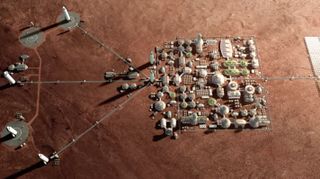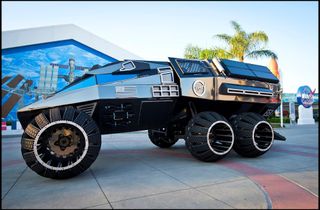Living on 'Mars 2': The Real Tech Behind Nat Geo's Martian Colony
Living on Mars

What will the first Mars colony look like? In National Geographic's "Mars" series, a group of pioneers build the first colony on Mars, complete with rovers, helicopters and other tech inspired by NASA, SpaceX and other "big thinkers" in the space industry. How does the fictional tech in Nat Geo's series match up to real-world ideas for how we'll colonize Mars? Shown here is Mars 2's fictional idea of a Mars base.
Next: SpaceX's Mars Base Vision
Mars Base Alpha

This mockup of SpaceX's planned Mars colony, named "Mars Base Alpha," shows multiple rockets parked at a safe distance from a cluster of pressurized buildings that serve different purposes in the Mars colony. Elon Musk plans to start building the Mars colony as soon as 2028,
UP NEXT: The spaceship
The Daedalus

This is the Daedalus — the spaceship that transports the crew from Earth to Mars in National Geographic's "Mars" series. It is named after the inventor and craftsman of Greek mythology, and it looks almost exactly like SpaceX's interplanetary ship, the BFR.
UP NEXT: The BFR
SpaceX's BFR

The BFR, which officially stands for "Big Falcon Rocket," is an enormous vessel that SpaceX is building to ship the first Mars colonists off to the Red Planet. Before this ship goes to Mars, though, it will fly around the moon with a crew of eight artists as early as 2023, Elon Musk said. [The BFR: SpaceX's Mars-Colonization Architecture in Images]
UP NEXT: Helicopter drones
Helicopter Drone

In the trailer for "Mars" Season 2, you can see a couple of small, four-bladed helicopter-looking drones flutter over the Mars colony. These seem to be based off a design for a drone that NASA will be sending to Mars in 2020.
UP NEXT: NASA's Mars Helicopter
NASA's Mars Helicopter

NASA plans to launch a small, autonomous helicopter along with its next Mars rover for a mission known as "Mars 2020." Flying on Mars is different than flying on Earth, because the planet's atmosphere is not as dense, giving the craft less of a lift. [How a Helicopter Drone Could Fly on Mars]
UP NEXT: Driving on 'Mars'
'Mars' Rovers

The rovers that astronauts drive in Nat Geo's "Mars" look a lot like NASA's Mars Rover Concept Vehicle, a six-wheeled, beefed-up Batmobile-looking tank that resides at the Kennedy Space Center in Florida. Unlike the rovers that are already on Mars today, these vehicles are controlled my drivers from the inside — not from a mission control center on another planet.
UP NEXT: NASA's Mars Rover Concept Vehicle
NASA's Mars Rover Concept Vehicle

If you thought Nat Geo's fake Mars rover looked cool, check out NASA's version of a drivable Mars rover! It hasn't been tested on the Red Planet, and it's not ready to launch anytime soon. However, it definitely drives, albeit at a meager speed of about 3 mph (5 km/h). [Watch Stephen Colbert and Neil deGrasse Tyson Drive the Mars Rover in NYC!]
UP NEXT: 'Mars' spacesuits
'Mars' Spacesuits

The original orange-and-gray suits the Mars colonists wore in Season 1 were designed to look like MIT's BioSuit concept, and they bore some resemblance to the suit Matt Damon wears in the film "The Martian." The new spacesuits in Season 2 are similar but sleeker; the Mars colonists now don black suits with an added "IMSF" emblem on the front.
UP NEXT: MIT's BioSuit
The 'BioSuit'

Researchers at the Massachusetts Institute of Technology have designed a skintight spacesuit known as the "BioSuit." Astronauts on Mars could wear these instead of the bulky pressurized suits, because they exert mechanical pressure onto the wearer's skin. [BioSuit: A Skintight Spacesuit for Astronauts (Photos)]
Join our Space Forums to keep talking space on the latest missions, night sky and more! And if you have a news tip, correction or comment, let us know at: community@space.com.
Get the Space.com Newsletter
Breaking space news, the latest updates on rocket launches, skywatching events and more!

Hanneke Weitering is a multimedia journalist in the Pacific Northwest reporting on the future of aviation at FutureFlight.aero and Aviation International News and was previously the Editor for Spaceflight and Astronomy news here at Space.com. As an editor with over 10 years of experience in science journalism she has previously written for Scholastic Classroom Magazines, MedPage Today and The Joint Institute for Computational Sciences at Oak Ridge National Laboratory. After studying physics at the University of Tennessee in her hometown of Knoxville, she earned her graduate degree in Science, Health and Environmental Reporting (SHERP) from New York University. Hanneke joined the Space.com team in 2016 as a staff writer and producer, covering topics including spaceflight and astronomy. She currently lives in Seattle, home of the Space Needle, with her cat and two snakes. In her spare time, Hanneke enjoys exploring the Rocky Mountains, basking in nature and looking for dark skies to gaze at the cosmos.
